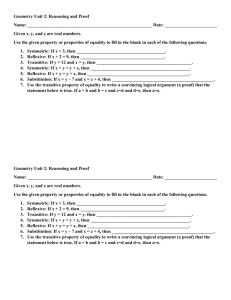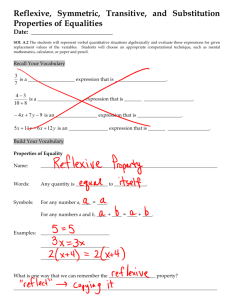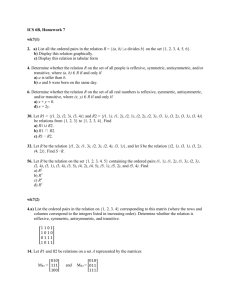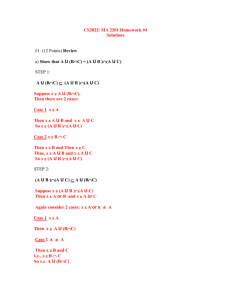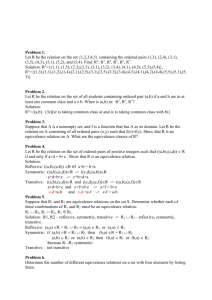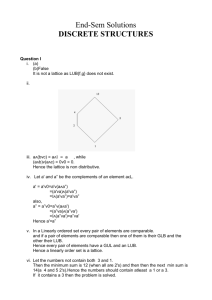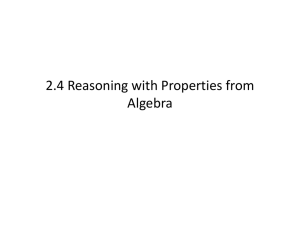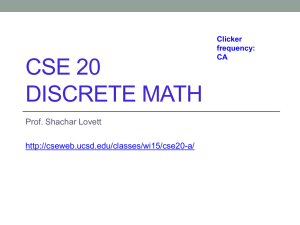The Symmetric, Reflexive, and Transitive Properties of Equality
advertisement
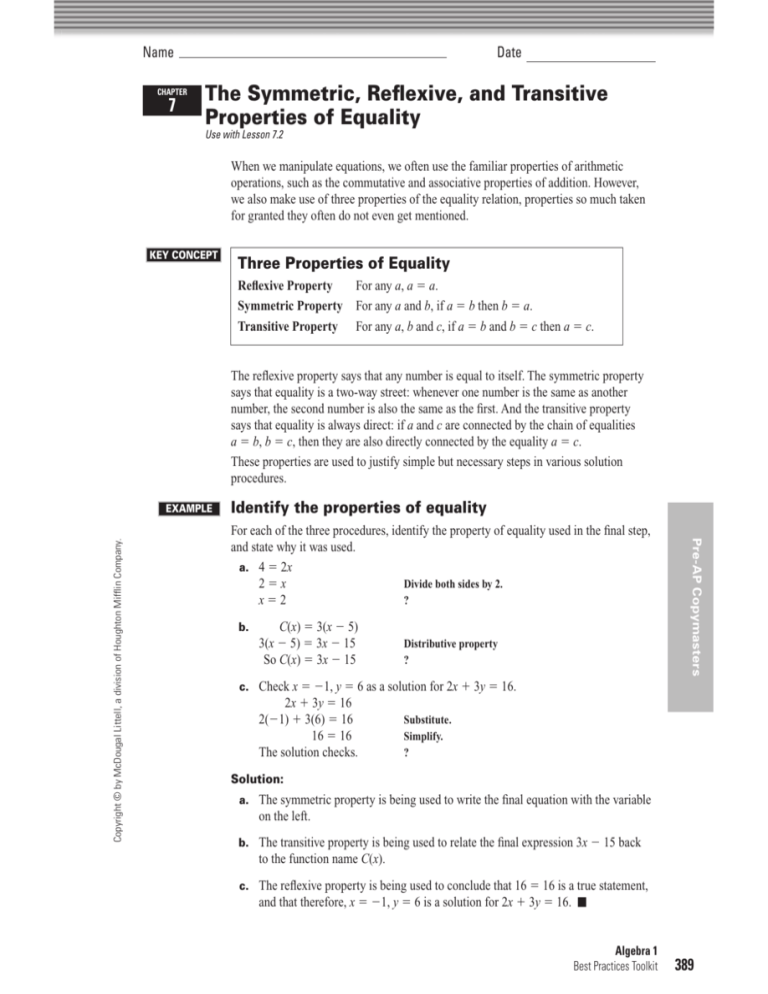
Name CHAPTER 7 Date The Symmetric, Reflexive, and Transitive Properties of Equality Use with Lesson 7.2 When we manipulate equations, we often use the familiar properties of arithmetic operations, such as the commutative and associative properties of addition. However, we also make use of three properties of the equality relation, properties so much taken for granted they often do not even get mentioned. KEY CONCEPT Three Properties of Equality Reflexive Property Symmetric Property Transitive Property For any a, a 5 a. For any a and b, if a 5 b then b 5 a. For any a, b and c, if a 5 b and b 5 c then a 5 c. The reflexive property says that any number is equal to itself. The symmetric property says that equality is a two-way street: whenever one number is the same as another number, the second number is also the same as the first. And the transitive property says that equality is always direct: if a and c are connected by the chain of equalities a 5 b, b 5 c, then they are also directly connected by the equality a 5 c. These properties are used to justify simple but necessary steps in various solution procedures. Identify the properties of equality For each of the three procedures, identify the property of equality used in the final step, and state why it was used. a. 4 5 2x 25x Divide both sides by 2. x52 ? b. C(x) 5 3(x 2 5) 3(x 2 5) 5 3x 2 15 So C(x) 5 3x 2 15 Distributive property ? Pre-AP Copymasters Copyright © by McDougal Littell, a division of Houghton Mifflin Company. EXAMPLE c. Check x 5 21, y 5 6 as a solution for 2x 1 3y 5 16. 2x 1 3y 5 16 2(21) 1 3(6) 5 16 16 5 16 The solution checks. Substitute. Simplify. ? Solution: a. The symmetric property is being used to write the final equation with the variable on the left. b. The transitive property is being used to relate the final expression 3x 2 15 back to the function name C(x). c. The reflexive property is being used to conclude that 16 5 16 is a true statement, and that therefore, x 5 21, y 5 6 is a solution for 2x 1 3y 5 16. N Algebra 1 Best Practices Toolkit 389 Name CHAPTER 7 Date The Symmetric, Reflexive, and Transitive Properties of Equality continued Use with Lesson 7.2 Part (c) of Example 1 actually assumes a fourth property of equality, which is quite important and is used frequently. KEY CONCEPT The Substitution Property of Equality For any a and b, if a 5 b, then b can be substituted for a in any equation. This is the property that allows us to substitute values in for variables in equations, or to replace one variable expression with another, equivalent variable expression. Practice Use the given property or properties to write an equation not already given. 1. 26y reflexive property 4. 8y 5 2x 1 9 symmetric property 7x 5 12 3. 3x 2 11 5 9, 9 5 2y symmetric property transitive property 5. 19 1 x 5 3x, 5 5 19 1 x 6. 3x 5 2y, (3x)2 5 8 transitive property substitution property 2. 7. 11a 5 5, 11a 1 9b 5 y, y 5 2z substitution property, transitive property Pre-AP Copymasters 9. Proof Show that if a 5 b, b 5 c, and c 5 d, then a 5 d. Challenge Do the reflexive, symmetric, and transitive properties apply to the inequality relations >, <, >, and < for real numbers? Explain your answers to each question. 10. Is the “greater than” relation a. reflexive? (Is a > a is true for any a?) b. symmetric? (When a > b, must it also be true that b > a?) c. transitive? (When a > b and b > c, is it also true that a > c?) 11. Is the “less than” relation a. reflexive? b. symmetric? c. transitive? 12. Is the “greater than or equal to” relation a. reflexive? b. symmetric? c. transitive? 13. Is the “less than or equal to” relation a. reflexive? b. symmetric? c. transitive? 14. Consider the “is 1 more than” relation, as in “x is 1 more than y.” Is this relation transitive? Why or why not? 390 Algebra 1 Best Practices Toolkit Copyright © by McDougal Littell, a division of Houghton Mifflin Company. 8. Proof Use two properties of equality to show that if x 5 y and x 5 z, then y 5 z.
